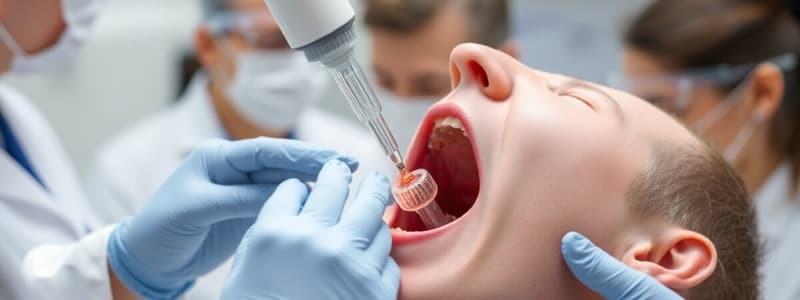Podcast
Questions and Answers
Why is it important to roll the swab back and forth near one edge of the blood agar plate before streaking?
Why is it important to roll the swab back and forth near one edge of the blood agar plate before streaking?
- To ensure the bacteria are evenly distributed across the agar surface
- To prevent the swab from touching the agar surface, which could contaminate the plate
- To create a concentrated area of bacteria for easier isolation and identification (correct)
- To ensure the swab is fully saturated with bacteria before streaking
When performing a catalase test on a colony from a blood agar plate, why is extreme care necessary?
When performing a catalase test on a colony from a blood agar plate, why is extreme care necessary?
- The catalase test is very sensitive and can be easily disrupted by contaminants.
- Erythrocytes from the blood agar contain catalase, which can lead to a false-positive result. (correct)
- The catalase test is only reliable when performed on pure cultures of bacteria.
- Blood agar can be contaminated with other bacteria, which could interfere with the test results.
Which of the following is NOT a reason to incubate the blood agar plate inverted?
Which of the following is NOT a reason to incubate the blood agar plate inverted?
- To increase the oxygen concentration available for the bacteria to grow (correct)
- To ensure that the agar surface remains moist and suitable for bacterial growth
- To prevent condensation from dripping onto the agar surface and interfering with colony growth
- To reduce the risk of contamination from airborne microorganisms
What is the purpose of using a sterile tongue depressor in this procedure?
What is the purpose of using a sterile tongue depressor in this procedure?
What is the purpose of characterizing the colonies and hemolytic types?
What is the purpose of characterizing the colonies and hemolytic types?
Why is it important to select well-isolated colonies for further testing?
Why is it important to select well-isolated colonies for further testing?
Flashcards
Throat Culture: Swabbing Technique
Throat Culture: Swabbing Technique
A sterile swab is used to collect a sample from the tonsillar area of the throat.
Throat Culture: Using a Tongue Depressor
Throat Culture: Using a Tongue Depressor
A sterile tongue depressor is used to gently hold the tongue down, allowing for easier access to the tonsillar area.
Throat Culture: Inoculation Technique
Throat Culture: Inoculation Technique
Roll the swab back and forth across a blood agar plate to transfer the throat sample. Then, use a sterile loop to streak the sample across the plate.
Throat Culture: Labeling the Plate
Throat Culture: Labeling the Plate
Signup and view all the flashcards
Throat Culture: Incubation Conditions
Throat Culture: Incubation Conditions
Signup and view all the flashcards
Throat Culture: Colony Observation
Throat Culture: Colony Observation
Signup and view all the flashcards
Study Notes
Throat Culture Procedure
- Collect a sterile throat swab sample, focusing on the tonsillar area.
- Use a sterile tongue depressor to manipulate the tongue and avoid interference.
- Streak the swab on a blood agar plate, rolling and streaking on one area of the plate.
- Label the plate with the site sampled and the medium type.
- Incubate the plate upside down at 35°C for 24-72 hours.
- Inspect the plate for bacterial growth (colonies).
- Identify the types of colonies based on characteristics.
- Choose isolated colonies that match common throat pathogens.
- Stain selected colonies using a Gram stain and conduct a catalase test on the same colonies.
- Exercise extreme caution when transferring colonies from the blood agar plate to avoid false-positive catalase results due to possible blood cell contamination.
Studying That Suits You
Use AI to generate personalized quizzes and flashcards to suit your learning preferences.




